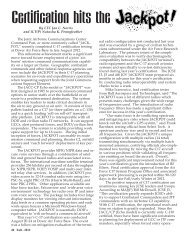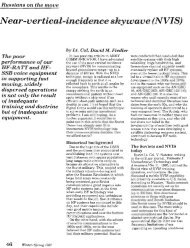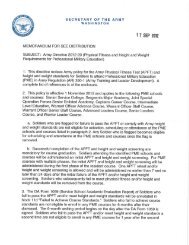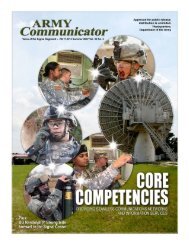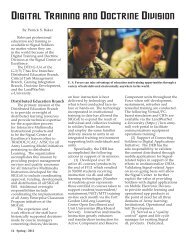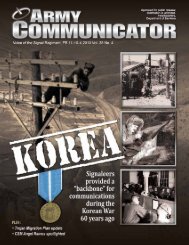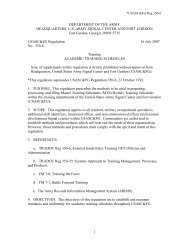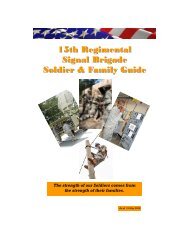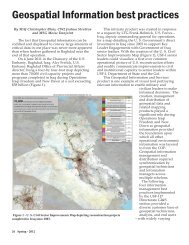AC Summer 08 WIN-T Online - United States Army Signal Center of ...
AC Summer 08 WIN-T Online - United States Army Signal Center of ...
AC Summer 08 WIN-T Online - United States Army Signal Center of ...
You also want an ePaper? Increase the reach of your titles
YUMPU automatically turns print PDFs into web optimized ePapers that Google loves.
LandWarNet NetOps Architecture<br />
signed a memo in 2004 stating<br />
that all DoD architectures would use<br />
the DoD Architecture Framework. If<br />
you have never looked at DoDAF<br />
products you might think they are<br />
just diagrams <strong>of</strong> the computer<br />
systems. In fact, the systems are just<br />
one <strong>of</strong> four different views within<br />
DoDAF. This framework also<br />
includes operational organizations<br />
and activities, which are tied to the<br />
systems views. This provides an<br />
integrated, overarching view <strong>of</strong> the<br />
entire operating environment. It also<br />
goes down to the data exchange and<br />
roles/responsibilities level <strong>of</strong> detail.<br />
This dovetails with the DoD Net-<br />
Centric Data Strategy. The LNA is<br />
also compliant with DoDAF.<br />
Now that we have given a little<br />
background, you are probably<br />
wondering just what is in the LNA?<br />
The LNA contains more than 40<br />
different NetOps capabilities (ability<br />
to perform some NetOps function),<br />
such as Host Intrusion Prevention<br />
System, which are grouped into five<br />
categories or “bins”. These five bins<br />
are IP Transport Management,<br />
Computing Platform Management,<br />
60 <strong>Summer</strong> 20<strong>08</strong><br />
Security Management, Enterprise<br />
Support, Enterprise Services and<br />
Applications Management, and<br />
Non-IP Transport Management.<br />
These 47 capabilities don’t exist<br />
in isolation. Like the DoDAF views<br />
they are all inter-related, and that is<br />
what is captured within the architecture.<br />
You may be thinking, this is all<br />
well and good, but so what. What is<br />
the value <strong>of</strong> the architecture to me?<br />
The LWN supports a multiplicity<br />
<strong>of</strong> users, across all <strong>Army</strong><br />
echelons from operating forces up to<br />
the interface to the Joint Community.<br />
Depending on where you are, you<br />
may have a different view <strong>of</strong> the<br />
LWN and how it supports your<br />
mission. For instance, many programs<br />
<strong>of</strong> record deliver or are reliant<br />
on LWN for their connection,<br />
computing, and/or NetOps capabilities.<br />
Depending on how a POR is<br />
designed it may interface and/or<br />
draw services from a Theater<br />
NetOps and Security <strong>Center</strong> or<br />
another network operations center in<br />
the <strong>Army</strong>. Instead <strong>of</strong> starting<br />
research from scratch, the LNA<br />
provides extensive requirements for<br />
NetOps capabilities/<br />
activities and how to<br />
interface to the<br />
TNOSC/NOC. The<br />
POR may not need<br />
all forty-seven<br />
capabilities contained<br />
in the LNA,<br />
but there is a high<br />
probability it will use<br />
many <strong>of</strong> them. The<br />
LNA team has put<br />
thousands <strong>of</strong> hours<br />
<strong>of</strong> research into how<br />
these capabilities<br />
should be used, and<br />
this effort can be<br />
leveraged by any<br />
organization that has<br />
to implement<br />
NetOps capabilities.<br />
Their research and<br />
products are coordinated<br />
with the<br />
<strong>Signal</strong> <strong>Center</strong> and<br />
the operational<br />
community. The<br />
U.S. Air Force<br />
absorbed the LNA<br />
into their NetOps architecture using<br />
it to cut their time to production.<br />
The LNA structure was used to<br />
develop the DISA NetOps Architecture<br />
and is used as the basis for the<br />
Joint Enterprise NetOps Architecture.<br />
Redundant, duplicative<br />
systems, at various <strong>Army</strong> echelons,<br />
run counter to <strong>Army</strong> objectives.<br />
Using the LNA across the <strong>Army</strong><br />
keeps us all moving in the same<br />
direction to achieving <strong>Army</strong> Campaign<br />
Plan objectives that drive<br />
global synchronization. Before<br />
implementing any new NetOps<br />
capabilities, the LNA should be<br />
reviewed to see if the requirements<br />
for implementing that capability<br />
already exist. The LNA review is<br />
actually part <strong>of</strong> the formal<br />
networthiness certification process.<br />
I haven’t gone into Clinger-<br />
Cohen and all the mandates to use<br />
architecture, because I think the<br />
common sense reasons probably<br />
resonate more strongly with the<br />
reader. Rest assured we are mandated<br />
to have an architecture, but I<br />
think the bottom line is it just makes



